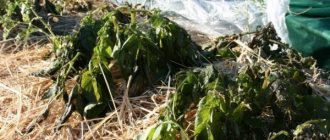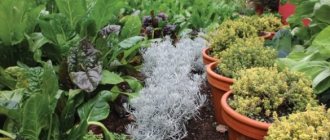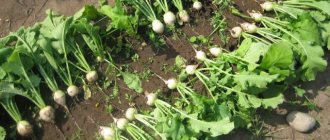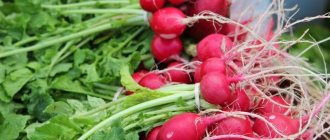- Growing autumn radishes - plant and get a harvest without hassle
- Pros of growing fall radishes:
- Radishes in autumn: growing conditions
- When to sow autumn radishes
- Radishes in autumn: soil preparation
- Features of sowing autumn radishes
- Caring for autumn radish crops
- Thinning radish crops
- Watering and fertilizing radishes in the fall
- Control of radish diseases and pests
- Radish pests: Cruciferous flea beetles
- Radish pests: Cabbage fly
- Radish diseases: Clubroot
- Autumn radish varieties
- Video: how to sow autumn radishes
Growing autumn radishes - plant and get a harvest without hassle
Gardeners often believe that the most delicious radishes are obtained only after spring planting. But this is not always the case, because when planted “before winter”, the plants grow more hardened and ready for any adverse weather conditions.
Growing autumn radishes.
Growing radishes in the fall differs in some ways from growing radishes in the spring. In the fall, radish root crops, remaining in the beds, retain commercial quality for a long time, so their harvesting can be extended until the onset of cold weather. Radishes are a fairly cold-resistant crop; they tolerate frosts down to -2°C well, so you don’t have to worry about the low night temperatures of September and October. Late planting of radishes has another advantage - the cruciferous flea beetle, the main enemy of radishes, is not as aggressive in the fall as in the spring, so the harvest is almost guaranteed.
Pros of growing fall radishes:
- Root crops can be stored in the beds longer in the fall, therefore, they retain their commercial qualities longer. You don’t have to rush into cleaning until the real cold starts.
- If you are a little late with harvesting, then radishes, rightfully considered a very cold-resistant crop, will perfectly tolerate frosts even a couple of degrees below zero. Therefore, due to the low temperatures that often occur in September and October, there is no need to worry too much.
And another advantage of autumn planting is salvation from the cruciferous flea beetle. As you know, this is almost the most terrible pest of radishes; in this case, in the fall, due to the cold, it may not manifest itself (but not 100%, of course), so the harvests will be intact, and chemicals should be used to protect against it no need.
Radishes in autumn: growing conditions
For good development of root crops, radishes need moisture, light and sufficient nutrition. The optimal air temperature for growing radishes is 16-20°C. A favorable condition for the formation of root crops is short daylight hours. If the length of daylight hours is more than 14 hours, the plant increases its green mass, quickly forms flower stalks and proceeds to flowering and the formation of seed pods, “forgetting” about root crops. When radishes are grown in the shade and with thickened crops, root crops do not form.
Young shoots will withstand any frost.
Radishes love fertile light loamy soils with a slightly acidic reaction (pH 5.5-7.0). On acidic soils there is a risk of clubroot infection. For varieties with elongated roots, it is important that the arable layer is deep enough - 18-20 cm.
Note! If you plan to grow radish varieties with elongated root crops, like carrots, then be sure to prepare the soil well; its arable horizon up to 20 cm should be perfectly cultivated.
An important condition for growing autumn radishes is good soil moisture, and if in early spring there is usually no problem with moisture, then in summer you need to pay serious attention to this. With a lack of soil moisture, radishes form coarse, unjuicy, bitter, and often ugly root crops. When humidity changes, root crops appear with constrictions.
Preparing the bed
How to plant radishes in late autumn if the ground is already frozen, heavy and difficult to loosen? It's simple, the bed needs to be prepared in advance. It is worth choosing a higher place so that when the spring thaw arrives, your seeds will not be flooded. The place should be well ventilated and with enough light; if there is insufficient lighting, the radishes will go green and the root crop will not form.
The soil for crops must be dug up and fertilizers applied. It should be loose, finely lumpy in structure and slightly acidic. You can use humus, compost or fertilizers (phosphorus-potassium) as an enrichment agent; here the choice is yours.
Shallow furrows should be made in the beds, up to three to five centimeters. Until the time of sowing, they should be covered so that the rains do not wash away the soil and bring weed seeds into the furrows. It is also necessary to prepare mulching material and dry soil in advance.
The soil for crops must be dug up and fertilizers applied.
When to sow autumn radishes
Usually large-fruited radish varieties, characterized by mid-ripening and late-ripening. Autumn radishes of mid-ripening and late-ripening large-fruited varieties are best sown at the end of July - the first half of August. In this case, large, shelf-stable root crops will be formed. For consumption “from the garden,” early ripening root vegetables can be sown a little later - in the third week of August and even in September, if the autumn is warm.
Planting radishes before winter requires certain conditions, but it has a number of advantages.
Radishes in autumn: soil preparation
Autumn radishes, as a rule, are grown in repeated plantings, so find out what is the best time to sow this crop in the garden. Good predecessors for it are garlic, cucumbers, which are just being harvested at this time, early potatoes, peas, beans and tomatoes, that is, almost any crops that have vacated the garden bed by this time, except for representatives of the cruciferous family (these are radish, daikon, cabbage, watercress -lettuce, horseradish), since they have common soil-transmitted diseases. If possible, it is also better not to plant radishes in an area where other root crops grew.
The soil for radishes is prepared immediately after harvesting the predecessor plant. On fertile soils, radishes can be grown without organic fertilizers; those applied to the previous year's crops are sufficient; if necessary, mineral fertilizers can be applied: 30-40 g of ammonium nitrate, 30-40 g of superphosphate, 40 g of potassium salt per 1 sq.m. .
Sow seeds with a reserve so that even if some of them are harvested, you will get a harvest.
On insufficiently fertile soils, humus or compost soil (10 liter bucket per 1 sq.m.) and garden mixture (40 g per 1 sq.m.) are added.
Loosen the soil to a depth of 15-20 cm, depending on the variety of radish - long-fruited varieties require deeper tillage. The soil should be watered before sowing; it should be well moistened.
What care does the garden bed need?
Right before sowing, it is necessary to calibrate the seeds. To do this, place them in small portions in a weak solution of table salt. It is prepared from the ratio of 2 tablespoons of salt per 1 liter of purified water. Keep them in the liquid for a short time, but do not forget to stir. Good live seeds will sink to the bottom of the container, while empty ones will float on the surface.
Having selected suitable specimens, etch them with a formaldehyde solution. The consumption of seeds during winter sowing increases by at least 50%, since most of them will not germinate due to freezing or can be eaten by rodents. It is important that they are dry. Already sprouted specimens cannot be planted; they have no chance of survival. We sow the prepared furrows with radishes.
Preparation of seed material
There is no need to water the soil during sowing, since it is already sufficiently moist at this time of year. Plus, additional irrigation can provoke the development of the plant, but it is of no use. We fill the beds with good soil (no more than 2 cm), which we stored at home or purchased at the store. Next comes a three-centimeter layer of mulch. It will protect crops from destructive temperature changes in the best possible way. It will also prevent crusts from forming on the soil when spring arrives.
Having considered how to plant radishes before winter, you should familiarize yourself with insulation technology. It is the same for most vegetables. Cover the beds with spruce branches; you can also use special synthetic materials. But foliage and straw will not be the best insulation for radish crops.
Preparation of seed material
We suggest you familiarize yourself with How to cover kiwi for the winter || How to cover kiwi for the winter
Features of sowing autumn radishes
Unlike spring sowings, summer radish sowings are carried out more sparsely, taking into account the size of the root crops of a given radish variety, so that all plants receive as much light as possible during the day.
Let's give an example: for example, for large-fruited radish varieties, it is desirable that the tape have from eight to ten lines, while the distance between the lines in the tape is better to be 12-14 cm, between seeds in rows - 6-7 cm, and between the tapes themselves – 40-45 cm.
Planting vegetables in open ground before winter requires compliance with certain conditions and rules: from choosing a location to soil characteristics.
The standard sowing rate for autumn radish seeds is approximately one gram per square meter. You can have a little (10-15%) more (if not everyone knows, let’s clarify: a gram of radish seeds contains up to 120-125 pieces, sometimes more).
The ideal time to plant radishes is when the weather is damp and fairly cool; if there is drizzle, then the weather itself is helping you. Before sowing, while waiting for drizzle, soak the seeds for 12 hours (usually overnight) before planting them in the ground.
When everything is ready, we go out to the garden bed, make grooves in it after 12-14 centimeters, lightly compact the bottoms of the grooves with our fingers and then water them with water, preferably from a spray bottle, after that we place them at a distance of about 5-7 cm (a lot depends on the type of radish here). seeds and carefully so that they do not move, sprinkle with soil. It is this kind of sowing that can protect the soil longer from the formation of a soil crust, through which it will be difficult for a sprout to break through.
Note! Plant radish seeds to a depth of one and a half to three centimeters. The depth depends on the soil: on dense soil 1.5 cm is enough, on loose and sandy soil - 2.5-3 cm, no more. If you place radish seeds very deeply, this will delay the emergence of seedlings: the above-ground mass breaking through to the top may come out later. But trying to go deeper (if planted shallowly), the root crop may end up looking ugly.
If we are not talking about a couple of acres, but about a large area that you want to occupy with autumn radishes, then it is better to calibrate the seeds before sowing them in the soil. Although this task is not quick, it will still be more convenient to plant each faction separately. Special sieves for seeds can speed up the situation; they divide the seeds into fractions - about 3 mm, from two to 2.5 mm and less than two millimeters in diameter. By sowing each calibrated fraction separately, you will get more uniform seedlings and much more even crops of autumn radishes.
Before autumn planting, the soil requires special care: fertilization, loosening and covering.
Naturally, everything does not end with sowing radishes into the soil; almost no less important work begins - caring for the seedlings and growing plants until harvesting. Maintenance usually includes watering, protection from diseases and pests, harvesting and preserving it.
Caring for autumn radish crops
In addition, do not forget about periodically, at least once a week, loosening the soil between the rows of radish crops, carrying out a series of fertilizing, watering, thinning out the emerging seedlings, and, as we have already said, controlling pests and diseases.
So, even before the radish shoots appear, you need to be on your guard; you need to mercilessly fight the soil crust by any means to eliminate it. Typically, the soil crust appears after rain or watering, usually abundant. The risk of soil crust formation can be somewhat reduced if the beds are mulched with very fine sawdust or river sand after sowing radish seeds and watering the soil. The slightest loosening helps, when the soil layers remain in place, as well as watering from a spray bottle, great if with rainwater.
If all is well, radish seedlings usually appear within four days; in rare cases, you will have to wait a little longer - up to seven days. Know that the seedlings may not be able to withstand the rays of the scorching sun, so at least for a couple of days, shade them from the sun. They will not tolerate excessive soil moisture, so water for three days only with a spray bottle, and around this time you can begin normalizing the crops.
Which variety should I plant before winter?
This type of planting has its own characteristics, so you should not take the first seeds you come across. In order for the work to yield good results, it is necessary to choose the right variety for sowing. Its main criterion is frost resistance. The plant will also experience a lack of sunlight. It is also important that the selected species does not bolt, since many, after a long stay in the frozen ground and then a sudden thaw, go into flowering shoots. At the same time, you will not be able to enjoy the fruits.
Frost-resistant varieties of radishes
Varieties such as “Zorya” and “Zhara” are perfect for winter planting. They meet all the requirements, and the harvest pleases with its taste and quality. The ripening period of the first type occurs on days 18–25 after germination, and the second one a few days earlier. You can also plant a mid-early pink-red variety. It will delight you with an excellent harvest within 3-4 weeks after germination. The main advantage of the latter is considered to be a mild and very pleasant taste.
Frost-resistant radish varieties
Thinning radish crops
You should not skip thinning the seedlings, since this is very important when growing autumn radishes. Thinning helps improve lighting of the plantation, increases the feeding area of each individual plant, and accordingly increases the overall yield from the site.
It is usually advisable to start thinning the root crops of autumn radishes a week after sowing. If they are developing very actively, then a day or two earlier, but you shouldn’t rush too much. It is necessary to achieve the emergence of truly massive seedlings and high-quality development of plants. Before thinning, the soil needs to be watered; it is better to do this with a spray bottle, moistening the soil by 2-3 cm.
Next, excess competing plants are simply pulled out of the ground carefully so as not to affect those located nearby. As a result, between the radish seedlings, depending on the variety, there should be a free distance of four or five centimeters. Next (after a couple of days), housewives usually select some radishes to use for food and thereby increase the distance between plants to eight or even ten centimeters. It is important to carry out uniform sampling so that the distance between plants is uniform.
For an example, based on my own experience (we will definitely describe radish varieties at the end), I can say that the optimal standing density, say, for the Dungansky radish variety is about one hundred plants per square meter, for the Red Giant and Zenit radish varieties it is less, about eighty or ninety pieces, and the earlier ripening varieties, of course, can be sown even thicker.
It is clear that even after thinning, the area in which radishes grow should be moist, loose, and free of weeds. This can be partially achieved by mulching: the same humus in a one-centimeter layer.
Thinning radish plantings.
When can you plant radishes before winter: timing
Correctly determining the time of planting is a very important moment. There is no specific date here. Work begins when the air is steadily cold to -1..0 degrees, and the soil is +2..+4. And such a temperature should not be short-term, but established for a long period of time with its subsequent decrease to sub-zero levels. As soon as light, stable frosts set in and the top soil layer (up to 3 cm) freezes a little, you can begin planting.
Photo: Planting should begin when the temperature becomes stable.
The most important danger is sudden thaws, which are mostly destructive for crops in winter. The seedlings that appeared due to sudden warming will die with further cooling. You should navigate here only by weather reports or the lunar calendar for your specific area. With the expected thaw, it is worth waiting out the work.
The most acceptable planting dates for the middle zone: from mid-October, for northerners: early October, southern summer residents can start in early to mid-November.
Watering and fertilizing radishes in the fall
Having briefly mentioned watering and fertilizing, let’s now talk about them in more detail. So, we all know well that radishes are demanding of moisture, especially when their root crops begin to form. Watering with a hose is not an option - you can wash away the soil, expose the root crops and pests will attack them. The best thing is to arm yourself with a watering can with small nozzles, this way you won’t wash out the soil and won’t damage the seedlings (you won’t break the foliage, press it to the ground, etc.).
If there is no natural moisture in the form of rain and it’s hot outside, then you need to water every three days, and if it’s really hot, then every two days. On light and sandy soils, you can water at least every evening, as long as the soil has time to dry out by the next evening. For those who like numbers, we can say that the watering rate for radishes is about 7-14 liters per square meter, depending on the plant variety, soil composition, its nutritional value, the presence of moisture in the form of rain, and other things.
Watering radishes must become a habit, become a regular, routine thing, otherwise the root crops may grow, but they will be bitter, even completely inedible. If there are changes in watering - for example, you haven’t been at the dacha for a long time, you came and flooded all the radishes, turning the beds into a swamp, then in addition to the constrictions that we wrote about above, the root crops can simply crack and begin to rot (also not an option, you know...) .
Feeding - this section is criticized in any article and, probably, will always be criticized. If you live well without fertilizers, then don’t add anything and... period. And those who understand that everything living, from humans to radishes, must eat, need to know more about feeding. So my personal suggestion is slurry. You need to dilute it 8-10 times with water, add 20-25 g of superphosphate and 10-15 g of potassium sulfate (not chloride or potassium salt) to the solution (usually in a bucket) - this is the norm for 2-3 square meters of bed. If it seems to you that your plants are developing significantly worse than your neighbor’s, then you can add one fertilizer with ammonium nitrate. Just dilute one gram of it in a bucket of water and water every square meter of soil in the area.
Of course, nitrogen fertilizers are not a panacea, I myself have always said, I say and will continue to say that it is impossible to abuse them, it is prohibited, it is contraindicated: in addition to the fact that instead of root crops they can stimulate the plant to form green mass, they will also have radishes inside ping pong ball: seemingly solid, but empty inside. After harvesting, such root crops usually begin to quickly deteriorate and simply rot. Well, yes, yes, yes (!): nitrates - they accumulate and cause harm to the human body (although, in my opinion, one walk along Tverskaya at rush hour is equal to a kilogram of eaten radish roots with a bunch of nitrates).
What lettuce can be planted before winter. Greens and root vegetables
It is difficult to imagine a garden without greenery growing in it. Every amateur gardener wants to grow vitamins for the table as early as possible. To get spring vitamins immediately after the snow melts, you can plant greens in the fall. In this case, the seeds:
- undergo hardening;
- the plant is not sick.
In the middle zone they plant in the fall in the garden:
- dill;
- cilantro;
- parsley;
- sorrel;
- salad.
When planting lettuce before winter, you need to choose leafy varieties; half-headed ones may not give the expected harvest.
Vegetable crops that can be planted in the fall include:
- cabbage;
- carrot;
- beet;
- radish.
To sow cabbage before winter, choose mid-ripe or late varieties; early ones are not suitable for such planting. Among the advantages of autumn planting it is worth noting:
- obtaining a harvest 2.3 weeks earlier than when planting in spring;
- Seeds receive moisture from spring melting snow and sprout quickly;
- freeing up spring time for growing seedlings of other crops;
- improved taste and juiciness;
- resistance to diseases and less losses from pests.
The disadvantages include:
- higher seed consumption;
- preparing beds for planting at the end of summer;
- the need to protect seedlings from frost in early spring;
- the need to accurately determine planting dates.
To plant beets in the fall, select varieties that are intended for autumn sowing and are resistant to bolting. Only a sunny place is suitable for beets; in the shade, it forms small, hard root vegetables with less sugar. The bed is prepared for sowing in advance, furrows are made at a distance of 30 cm from each other and a depth of about 5 cm. They wait until the temperature reaches -2 to +5 degrees. Beets are sown more often than during spring planting. The furrows are covered with pre-prepared soil, mulch in the form of peat, humus, compost is added on top and covered with branches of coniferous trees.
You can also plant beet and carrot seeds before winter. Early and cold-resistant varieties are suitable for planting. Preparing the planting site is done in the same way as a bed for beets.
Control of radish diseases and pests
With watering, fertilizing and loosening the soil, which some individuals even do with combs and toothpicks, we forgot about diseases and pests, and the good neighbor did not try and exterminate them while we were arguing about the “benefits” of nitrates.
To avoid many radish diseases, it is necessary to follow the rules of crop rotation.
As we have already mentioned in this article, one of the most dangerous pests for radishes is the cruciferous flea beetle. Yes, she is not so active during this period of time, but it cannot be said that she is inactive at all. There have been cases when you believe such promises, you go out to an area where only yesterday there were friendly and cheerful shoots of autumn radishes, but they are completely gone. Therefore, it is better to overdo it. Do you know what this flea does? It eats away a sweeter, more nutritious and important, it seems, both for it and, of course, for the plants themselves, growth point, and if the weather is dry and hot, then you definitely need to be ready.
Radish pests: Cruciferous flea beetles
Nobody recommends using chemicals to control cruciferous flea beetles. We take the most terrible allergen, having previously put on protective gloves and a respirator - mustard and carefully, a very tiny pinch, sprinkle the rows of radishes. You can also use hot ground pepper, and you need a maximum of a teaspoon of mustard and pepper per square meter. After this, the crops need to be covered with a non-woven covering material, creating something like a greenhouse with a chemical attack on flea beetles.
Cruciferous flea beetles on radishes.
An original way to protect radishes from cruciferous flea beetle:
About seven days before sowing radishes in the ground, it is necessary to sow watercress and mustard, and after another seven days, sow radishes in the rows of these crops. We act like Sherlock Holmes: the flea attacks the seedlings of competitors, we treat them with approved insecticides, strictly following the instructions on the packaging, and kill them, after which we just have to wait for the radishes to sprout and cut off the plants we don’t need that serve as bait. This method may well help, you can try it.
Radish diseases: Clubroot
As we already mentioned, acidic soils can be dangerous for radishes due to clubroot damage. If you are able to determine the pH of the soil or know that it is definitely acidic, then before sowing we recommend adding 150-200 g of chalk, 250-300 g of lime or 250-350 g of dolomite flour to the soil, of course, calculated per square meter and , ideally, for a year, but it is possible at least a month before sowing the radishes. Wood ash is a good soil deoxidizer; among other things, it contains up to 5% potassium and a fairly large composition of microelements, although in small quantities. Wood ash can be sprinkled in a millimeter layer directly into the base of the hole, and radish seeds can be sown on top.
Overgrown radish.
Autumn radish varieties
Well, of course, the key to success is determining the correct degree of ripeness of the radish root crop. To do this, you need to know what you are sowing on the plot, that is, the variety and the duration of its maturation from the emergence of seedlings to the production of edible root crops. We have prepared for you a list of radish varieties that have performed best, especially when sowing in autumn.
Typically, these radish varieties are suitable for sowing in August, are ready for harvesting in a maximum of two months and produce fairly large root crops, reaching hundreds of grams. Such root vegetables can be stored in the cellar for up to six months.
- Autumn giant - only 26-28 days pass before it is harvested, the root crops reach a mass of 145 g, they are white, elliptical in shape, with juicy pulp and excellent taste. They can be stored for up to one hundred days.
- Red giant - approximately 52 days pass before harvest, root crops reach a length of 11-13 cm. The variety gives a yield of 3.3 kg per square meter. Very tasty and can be stored for up to 120 days.
- Dungan - about 55 days before harvest and almost the same average weight of the root crop (35-45 g), with a yield of up to 3.5 kg per square meter. The root vegetable of this radish has an excellent taste.
- Zenith - from 31 to 39 days before harvesting, the color of the root crop is pink-crimson, cylindrical in shape, up to 15 cm long, and about three centimeters in diameter. Maximum weight 75 g, sometimes slightly raised above the soil surface. The pulp is interesting - it is very dense, white in color and has a pungent taste. Productivity up to three kilograms per square meter. Capable of long-term storage.
- Saxa – 31–35 days pass before harvesting. The color of the root vegetable is red-crimson, oval in shape, diameter up to four centimeters, weight no more than 30 g. The pulp can be either snow-white or pinkish, very dense, a little sharp. From a square meter you can dig up to one and a half kilograms of radish of this variety.
- Würzburg - usually 33-36 days pass before harvesting. The color of the root vegetable is red-crimson, it has a round shape and a diameter of about four centimeters with a weight of 15-16 g. The pulp is usually snow-white, but can also be white-pink, the taste is slightly pungent. From a square meter you can harvest almost two kilograms of crop.
- Heat - the first harvest of this variety can be harvested within a month after germination. The color of the root crop of this radish is red-crimson, the shape is either round or oval, and the diameter reaches 3.5 cm with a mass of about three tens of grams. The pulp can be either snow-white or pinkish, quite dense with a slightly pungent taste. You can harvest up to 2.5 kg of crop per square meter.
- Rizenbuter - this variety can be grown at atypical times both in open ground, where it is ready for digging in 24-26 days, and in protected ground, where it takes about the same amount of time. As a result, a red root crop is formed, round in shape, with a diameter of about ten centimeters. The average weight of the root crop is about 35 g. The pulp of this radish variety is snow-white, very juicy and sweet.
- Well, in conclusion, my favorite variety of radish is Queen Margot - less than a month passes from germination to digging it up, this variety produces round-shaped root crops, weighing just over 23 g. The pulp is white as snow, quite dense, crunchy when consumed, very juicy and, as they say, scientists, “chocked” with vitamins. Interestingly, the germination rate of seeds of this variety always approaches 100%.
Vegetables for early harvest: (read more)
As you understand, getting an early radish harvest is not as difficult as it seems. It is important to choose the seeds correctly, not to make mistakes with the sowing time, and to reliably cover the bed in advance of severe frosts. The possible risk associated with natural anomalies is not a reason to give up trying to treat your loved ones with a delicious vitamin-rich vegetable from your own garden in the spring.
Radish in winter. Growing radishes at home on a windowsill in winter
By planting radishes in the fall, you can count on a healthy, high-quality and early harvest, and all thanks to natural selection. The seeds will have to endure frost in the ground, and only the strongest and strongest will sprout in the spring. As a result, the quality of the crop increases sharply. You may even be able to save a little time and effort on weeding.
High-quality early harvest of radishes
Also, thanks to the melting of the snow cover, the radish will receive a sufficient amount of moisture and does not need to be watered; the soil is moistened naturally. In addition, seeds that have passed natural selection are hardened in winter, and young shoots are not afraid of slight frosts; they are resistant to various diseases and insects. And, of course, don’t forget about saving spring time.
Frost-resistant young shoots
Are there any disadvantages to planting radishes before winter? If you do not maintain the technology correctly, then there is a high risk that all your efforts will be in vain. Even a slight warming poses a danger, which can provoke the growth of seedlings, and subsequent frosts will simply kill them.
Radishes are the most popular vegetable of the salad season with a pleasant, slightly spicy taste. The most attractive feature of this root vegetable is its early ripening - for some varieties the ripening time can reach only 16 days.
Thus, in one season (from April to August) this crop can be planted up to 4 times and still receive a full harvest. In this regard, it is convenient to distinguish three large groups of varieties of this crop, depending on the ripening time of the root crop:
- early (time from planting to harvest 17-25 days)
- average (from 25 to 35 days)
- late (from 25 to 40 days)
This division is most preferable. As can be seen below, the varieties still have characteristic features in each of the groups.
It is worth mentioning the following groups, distinguished by the shape of the root crop: (round, cylindrical, conical, icicle-shaped), by skin color (light red (pink), bright red, crimson, yellow, white) and by weight (from 10 g to 100 g and above).
Each of them, in turn, has certain characteristics of growing and obtaining the best root crops - in connection with which the following are also distinguished:
- suitable for planting in open ground
- for planting in a greenhouse.
At the moment, there are a huge number of different varieties, which, if chosen correctly, will be optimally suited for any purpose and method of cultivation - you just need to understand the features of growing this crop and build on your preferences and capabilities.
The issue of planting vegetable crops before winter often worries beginning gardeners. And if you have never done this, but want to try this year, then you need to know the most important points thanks to which the harvest can be successful. And today we are talking about radishes.
Planting radishes before winter has a lot of advantages. This includes earlier harvesting (2-3 weeks earlier than spring sowing), and no need to monitor the watering of the bed at first, since snow melting provides the planting with the necessary moisture. Radish seeds undergo hardening in the soil in winter and become strong, and therefore they are not afraid of sudden temperature changes or frosts.
Deadlines
It is worth planting radishes when there is a stable sub-zero air temperature. You can plant even when the air temperature is zero, but in this case you need to know that if there is a possibility of a thaw, this can destroy all the crops. Therefore, the ground must be frozen and the temperature must be sub-zero. As a rule, this is a period of time from the end of October to the end of November, depending on the region.
Preparing the bed
The bed for planting winter radishes must be prepared in advance. To do this, dig up the ground now, add humus, compost and fertilizers (phosphorus-potassium). Make grooves 4-5 cm deep in the bed and cover with film.
Prepare dry soil, which must first be brought indoors to be poured into the furrows after planting.
Seeds must be sown dry! At the same time, you need to understand that all seeds will not survive the winter 100%, which is why, as with normal winter sowing, it is necessary to increase the seed rate for sowing. After you sow the seeds in the furrows, you need to sprinkle them 2-3 cm with dry soil and then also pour dry soil in the form of mulch on top of the bed for another 2-3 cm. Cover the top with spruce branches, branches, leaves with a total thickness of 15 cm.
Varieties
Well, we must not forget such a factor as the variety of radish. It is necessary to use varieties that are resistant to frost. This can be “Zarya”, “Zhara” and other types of radishes.
Compliance with these factors of autumn sowing of radishes before winter will allow you to enjoy this vegetable in early spring.
Today, a large number of radish varieties are known. They can be suitable for planting both in open ground and in greenhouse conditions; they differ in terms of ripening and tendency to form shoots. You will learn about what types of radish there are, and what other characteristics they differ in, by reading this article.
We invite you to familiarize yourself with DIY cardboard furniture: diagrams and templates
During intensive bolting, most nutrients are consumed, and the fruits lose their juiciness and taste. But there are radish varieties that are resistant to shoots. This feature is highly valued by gardeners.
Variety characteristics:
- the fruits are large, rich red, can reach 9 cm in diameter;
- inside the fruit there is white pulp of a dense structure;
- It has a pleasant taste with sweetish notes.
The variety ripens within 25 days.
Early red
Options:
- fruits can reach 15 g in weight;
- the flesh has a soft pink color;
- retains high taste even during long-term storage.
Fully matures 20 days after planting.
Description of this variety:
- fruits of unusual yellow color;
- white crispy flesh inside;
- suitable for transportation over long distances;
- high color resistance;
- tolerates heat and drought well.
About 20 days should pass from the appearance of sunrise to harvest.
Vera MS
Can be distinguished by the following characteristics:
- 1 fruit can weigh up to 25 g;
- has a delicate and pleasant taste;
- known for high productivity;
- good resistance to cracking.
Ripens in about 35 days.
Rampoush
Please pay attention to:
- white fruit color;
- elongated radish shape;
- lack of pronounced bitterness in taste.
Fully matures in 35-40 days.
Early ripening
Early ripening radish varieties are characterized by full ripening within 16-25 days. In this case, the plants do not require special care, except for timely watering.
It is better to plant early ripening varieties in early spring.
18 days
The following qualities of the variety are called:
- the fruits are cylindrical, elongated;
- the weight of 1 radish reaches 18 g;
- the pulp is white, has a dense structure;
- the taste is pleasant, with a slight bitterness.
This variety, as its name implies, ripens in 18 days.
Presto
Notable Features:
- fruits can reach 3 cm in diameter and 25 g in weight;
- the pulp is very juicy, without bitterness;
- requires special temperature conditions;
- resistant to many common diseases.
Ripens in a record short time - 16 days.
- light weight of 1 radish – 10 g;
- pale pink color of the pulp;
- pleasant taste with a slight bitterness;
- color resistance.
It bears fruit within 20 days after sunrise appears.
Carmen
Important characteristics:
- the weight of 1 fruit reaches 30 g;
- skin color – bright red;
- the pulp is white, juicy, has a pleasant islandy taste;
- resistant to many diseases;
- Suitable for long-term transportation.
Ripens in 20 days.
Alex F1
Description of the hybrid:
- fruit weight ranges from 20 g;
- the pulp has a pleasant sweetish taste;
- is resistant to low light conditions;
- can be grown in a greenhouse in winter.
The ripening period does not exceed 18 days.
Mid-season
The ripening period of mid-season varieties ranges from 25 to 35 days. The advantages of varieties of this type include high yield and longer shelf life.
Variety characteristics:
- white skin;
- the fruits are oval in shape;
- the weight of 1 fetus ranges from 35 g;
- It has a pleasant taste, almost without bitterness.
Ripens within 35 days.
Würzburg 59
The traits of the variety include:
- the fruits are round, about 4 cm in diameter and 20 g in weight;
- the skin has a bright red color;
- the pulp is soft pink, tastes almost without bitterness;
- Resistant to cracking.
Fruiting occurs after 25 days.
Peculiarities:
- fruits with a diameter of 4 cm and a weight of 30 g;
- skin color is crimson;
- vegetables are round or slightly elongated;
- susceptible to coloration.
The harvest can be harvested after 28 days.
Tarzan F1
Characteristics:
- the fruits weigh about 50 g and reach 7 cm in diameter;
- bright red skin;
- the pulp has a slightly spicy taste;
- resistant to many common diseases.
The ripening period is within 35 days.
High-quality early harvest of radishes
Frost-resistant young shoots
Growing radishes yourself at home is the easiest and fastest way to replenish vitamin deficiency in the winter. The advantages of winter cultivation of this particular vegetable are early ripening, minimal care, and simplicity of agricultural technology. There are radish varieties that only take two and a half weeks from planting to full maturity. By planting vegetables in stages, you can provide yourself with fresh vitamins throughout the winter.
It must be said that not every variety of radish is suitable for growing at home on a windowsill. You need to choose hybrids that have an ultra-early ripening period or early ripening varieties. It should also be shade-tolerant and drought-resistant, since in winter in city apartments heating appliances dry out the air too much. Insufficient humidity can cause the plant to bloom.
- 1 “18 days” - as the name suggests, the root crop ripens in eighteen days and this is true. Maximum three weeks - can be served. A plant with excellent immunity, bright red color, cylindrical, elongated root, very juicy, not bitter.
- 2 "Duro" - spherical, large fruits (approximately 40 grams), pale pink flesh. The early ripening variety "Duro" ripens in twenty-five (or so) days. Does not crack, is resistant to stemming.
- 3 “Heat” is a round root vegetable with a dark red color. Ripens in approximately 27 days. Not spicy taste, tender, pink flesh.
- 4 “Ilka” is another ultra-early variety. The ripening period is twenty days. The root vegetable is not large, on average eighteen grams. It has a long shelf life. Very spicy taste.
- 5 “Camelot” is an early maturing hybrid. It has a round, slightly flattened shape. From planting the seed to the full ripening of the vegetable, approximately twenty-five days pass. The variety is shade-tolerant. "Camelot" is easy to care for.
- 6 “Firstborn” is a hybrid, ultra-early, ripens in just seventeen days! Round fruits weighing thirty-five (or so) grams. Does not shoot, color is dark red.
- 7 “French Breakfast” is the most suitable variety (according to most experienced vegetable growers) for growing at home. “French Breakfast” is the best choice for a novice home vegetable gardener. The variety is easy to care for and does not go away, as they say. The seed matures from germination in 20-23 days. Spicy taste, rich aroma. Fruit weight is up to forty-five grams.
- 8 “Helro” - Dutch hybrid does not require intense lighting. Tolerates insufficient humidity very well. The early ripening variety is ready to serve twenty days after germination.
We suggest you read: Can children eat ginger (at what age can they eat it, how much per day can they eat)











